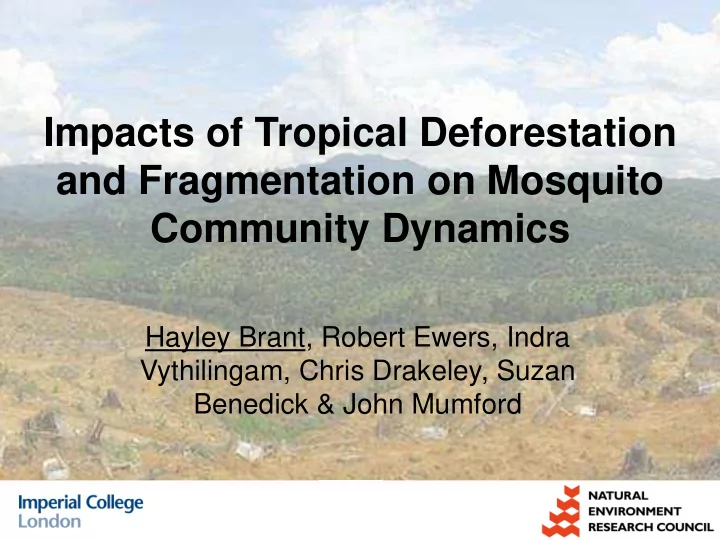

Impacts of Tropical Deforestation and Fragmentation on Mosquito Community Dynamics Hayley Brant, Robert Ewers, Indra Vythilingam, Chris Drakeley, Suzan Benedick & John Mumford
Land Use Change • Land use and land cover changes modify: – temperature – relative humidity • Affects mosquito: – survival – density – distribution
Deforestation in SE Asia • It is predicted that South-east Asia could lose up to three quarters of its original forest and 42% of its biodiversity by 2100 (Sodhi et al. 2004). • Malaysia is one of the top fourteen deforesting countries, losing 250,000 ha or more annually (McMorrow & Talip 2001) Bradshaw et al. 2008
Research Question • What is the effect of land use change on: – Abundance – Community composition – Biting times of mosquitoes in Sabah, Malaysia
Old growth forest Logged forest Oil palm plantation
Field site (S.A.F.E. Project) Ewers et al. 2011
Bare leg catches • Human landing catches (5-11pm) • 92 night collections within oil palm plantations, old growth forest and logged forest • To collect anthropogenic crepuscular mosquitoes • Red torch light to seek out mosquitoes
Species collected • 2245 mosquitoes collected • Old growth= 11 species • 7 Anopheles species (83% of catch) • 4 Culicine species • Secondary forest= 31 species • 11 Anopheles species (99% of catch) • 20 Culicine species • Oil palm= 16 species • 8 Anopheles species (86% of catch) • 8 Culicine species
Species collected Old growth Logged Oil palm Species Number % Number % Number % An. balabacensis 13 18.1% 1272 76% 356 71.3% An. Leucosphyrus group 6 8.3% 152 9.1% 9 1.8% An. aitkenii 5 6.9% 70 4.2% 0 0.0% An. macarthuri 1 1.4% 45 2.7% 26 5.2% An. maculatus 0 0.0% 7 0.4% 25 5.0% An. latens 32 44.4% 28 1.7% 2 0.4% Ae. albopictus 0 0.0% 6 0.4% 46 9.2% Cx. quinquefasciatus 0 0.0% 0 0.0% 12 2.4% Arm.jugraneus 4 5.6% 5 0.3% 0 0.0%
Logged Old Am. orbitae An. barbirostris forest growth An. kochi Coq. crassipes Arm. flavus An. aitkenii gr. Cx. bitaeniorhynchus Col. pseudotaeniatus An. watsonii He. scintillans Arm. jugraensis Ma. annulata Pr. ostentatio Orthopodomyia sp. Stg. gardnerii An balabacensis Verrallina sp. An latens Zeugnomyia sp. An. macarthuri An . Leucosphyrus gr. An. vagus An. maculatus An. tessellatus Cx. (Culiciomyia)sp. Cx. gelidus Cx. vishnui Cx.quinquefasciatus Downsiomyia sp. Cx. sitiens Ae. albopictus Oil palm
Biting times ( Anopheles )
Biting times (Culicines)
Conclusions • Large number of mosquitoes in logged forest & oil palm • Each area has a different community composition • Peak biting time 6-8pm for Anopheles in logged forest & oil palm • Anopheles from the Leucosphyrus group were present in all areas
Acknowledgements • John Mumford, Rob Ewers, Chris Drakeley, Indra Vythilingam, Suzan Benedick, Tilly Collins • SAFE Project: Minsheng Khoo, Jonny Larenus, Glen Reynolds, Sarah Watson, my research assistants and other scientists and staff at the SAFE Project • Universiti of Malaya: John Jeffrey, Wong Meng Li • NHM: Ralph Harbach, Theresa Howard, Erica McAlister • NERC for funding this project, as well hayley.brant10@ic.ac.uk as the funders of the SAFE Project http://www.safeproject.net/ • This project was approved by SaBC, IMR, ICREC, MREC, MBMC & SEARPP
References • Bradshaw, C.J.A., Sodhi, N.S. & Brook, B.W. (2009) Tropical turmoil: a biodiversity tragedy in progress. Frontiers in Ecology and the Environment, 7 , 79-87 • Bunnag, T., Sornmani, S., Phinichpongse, S. & Harinasuta, C. (1979) Surveillance of water- borne parasitic infections and studies on the impact of ecological changes over vector mosquitoes of malaria after dam construction. Southeast Asian Journal of Tropical Medicine and Public Health , 10 , 656-660. • Ewers, R.M., Didham, R.K., Fahrig, L., Ferraz, G., Hector, A., Holt, R.D., Kapos, V., Reynolds, G., Sinun, W., Snaddon, J.L. & Turner, E.C. (2011) A large-scale forest fragmentation experiment: The Stability of Altered Forest Ecosystems Project. Philosophical Transactions of the Royal Society B , 366 , 3292-3302. • Gratz, N.G. (1999) Emerging and resurging vector-borne diseases. Annual Review of Entomology , 44 , 51- 75. • Manga, L., Toto, J.C. & Carnevale, P. (1995) Malaria vectors and transmission in an area deforested for a new international airport in southern Cameroon. Annales de la Societe Belge de Medecine Tropicale , 75 , 43-49. • Mackenzie, J.S., Gubler, D.J. & Petersen, L.R. (2004) Emerging flaviviruses: the spread and resurgence of Japanese encephalitis, West Nile and dengue viruses. Nature Medicine , 10 , S98-109. • McMorrow, J. & Talip, M.A. (2001) Decline of the forest areas in Sabah, Malaysia: Relationship to state policies, land code and land capability. Global Environment Change, 11 , 217-230. • Sodhi, N.S., Koh, L.P., Brook, B.W. & Ng, P.K.L. (2004) Southeast Asian biodiversity: An impending disaster. Trends in Ecology and Evolution , 19 , 654-660. • Vittor, A.Y., Pan, W., Gilman, R.H., Tielsch, J., Glass, G., Shields, T., Sánchez-Lozano, W., Pinedo, V.V., Salas- Cobos, E., Flores, S. & Patz, J. A. (2009) Linking deforestation to malaria in the Amazon: characterization of the breeding habitat of the principal malaria vector, Anopheles darlingi. The American Journal of Tropical Medicine and Hygiene , 81 , 5 – 12. • Walsh, J.F., Molyneux, D.H. & Birley, M.H. (1993) Deforestation: effects on vector-borne disease. Parasitology , 106 , S55 – 75.
Recommend
More recommend